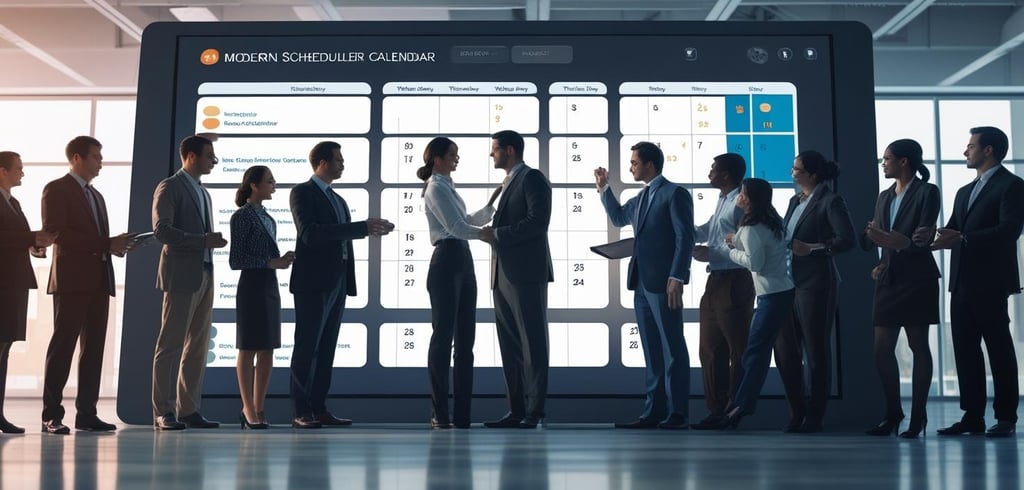Start sending invites for free - no card required - Click here
The Modern Calendar Invite: Structuring Time in a Digital World
In an era defined by speed, remote collaboration, and global interactions, managing time effectively has become more critical than ever. At the heart of efficient time management lies the often-overlooked tool: the calendar invite. From coordinating global teams to scheduling social gatherings, this simple function plays a powerful role in aligning people across locations and time zones.
BLOGS
7/8/20253 min read


In an era defined by speed, remote collaboration, and global interactions, managing time effectively has become more critical than ever. At the heart of efficient time management lies the often-overlooked tool: the calendar invite. From coordinating global teams to scheduling social gatherings, this simple function plays a powerful role in aligning people across locations and time zones.
Whether you're an individual professional, a team leader, or part of a large organization, understanding how calendar invites work can significantly improve how you plan and communicate.
What Is a Calendar Invite?
You may have asked yourself, "what is a calendar invite?" It’s more than just a digital reminder. A calendar invite is a structured message sent via email or calendar platforms that adds an event directly to the recipient's calendar. It includes essential details like time, date, location (virtual or physical), agenda, and any necessary attachments or links.
With one click, recipients can accept or decline the invite and automatically sync it across devices—making coordination easier and more transparent for everyone involved.
Cross-Platform Scheduling: Outlook & Gmail
Today’s professionals use various platforms for scheduling. A calendar invite Outlook users receive typically integrates with email, shared calendars, and video conferencing platforms. It streamlines communication and allows updates or cancellations to reflect automatically.
Similarly, those who send meeting invite in Gmail benefit from Google Calendar's intuitive design, enabling users to easily schedule events, add participants, and attach files or links within the same interface. Regardless of the platform, the goal is the same: seamless coordination.
The Need for Bulk and Mass Calendar Planning
As teams scale and projects become more collaborative, scheduling grows increasingly complex. That’s where bulk calendar coordination steps in. Instead of sending one invite at a time, professionals can now create events that are distributed to many recipients simultaneously.
Managing a calendar in bulk ensures consistent communication across:
Internal all-hands meetings
Community-driven campaigns
Training or onboarding sessions
Recurring webinars and public events
A consistent format not only saves time but also reduces the risk of scheduling errors or miscommunication.
Why Mass Calendar Scheduling Matters
When the number of attendees reaches into the hundreds or thousands, scheduling shifts from individual coordination to mass calendar management. This is especially useful for:
Product launches
School and university sessions
Investor or stakeholder briefings
Health and safety updates across organizations
The mass approach lets event organizers send a unified message to all invitees, with the ability to update details centrally and have changes reflected in real-time.
Event Invites That Work
Not all event invites are created equal. To get the most value from your scheduling efforts, it’s essential to craft invites that are clear and informative. An ideal event invite includes:
A clear, concise title
A description outlining the purpose or agenda
Date and time with the correct time zone
A virtual link or physical location
Optional attachments like presentations or documents
A reminder or alert setting to boost attendance
Keeping your invites well-structured ensures that attendees are informed, prepared, and more likely to show up.
Sending Meeting Invites Effectively
When you send meeting invite notifications, be mindful of your recipients' availability and preferences. The best practices include:
Avoiding scheduling conflicts by checking shared calendars
Adding relevant team members only
Personalizing the message if needed
Sending invites well in advance with a short description of the meeting’s purpose
Thoughtful scheduling shows professionalism and helps avoid last-minute cancellations or confusion.
Invite Software: Optional, Not Essential
As digital workspaces expand, many professionals explore invite software to manage large-scale scheduling tasks. While software may offer enhanced features like RSVP tracking, automated reminders, or analytics, the fundamental principles of effective scheduling remain unchanged: clarity, timing, and reliability.
Even without advanced tools, well-executed calendar invites can fulfill most scheduling needs.
Conclusion
Calendar invites are the unsung heroes of digital productivity. They simplify scheduling, reduce communication overhead, and keep everyone aligned. Whether you're managing a bulk calendar or organizing a mass calendar event, mastering the basics of structured invites can dramatically improve your ability to coordinate across teams, time zones, and technologies.
With proper planning and clear communication, calendar invites ensure time is used wisely—one meeting, event, or collaboration at a time.
BulkCalendar.in
Send Bulk & Mass Calendar Invites Instantly
Contact us
Engagement
sales@letscalendar.com
+44 (0) 203 916 5117
© 2025. All rights reserved.
Help?
